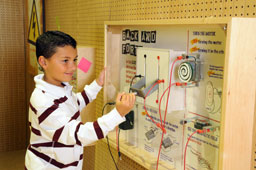by Diane Burdick, Ed.S
Comment on this post and be entered to win $20 to spend at The School Box
Kids love counting down to Christmas. After all, it is one of the most exciting times of the year! But just how do you get ready for the season? If your answer is simply x-ing out the days on a calendar, might we suggest a few fun crafts to add to your classroom Christmas tradition repertoire?
Santa’s Disappearing Beard
 This idea, found here, is super simple to make!
This idea, found here, is super simple to make!
1. Create a long Santa beard from lined paper (like notebook paper).
2. Add a face from construction paper.
3. Then clip off one line’s worth of the beard each day.
The shorter Santa’s beard gets, the closer you are to Christmas. Not only will kids enjoy snipping Santa’s beard, but it helps them visualize the length of time left before Christmas.
Merry Muffin Tins
 Maybe instead of a traditional counting down calendar, you want give tiny gifts too. Sure, you could spend lots of money on a container, but consider repurposing something you already have around the house — a 24 count muffin tin — into the perfectly portioned gift container. Thanks to Heartland Paper for this ingenious idea!
Maybe instead of a traditional counting down calendar, you want give tiny gifts too. Sure, you could spend lots of money on a container, but consider repurposing something you already have around the house — a 24 count muffin tin — into the perfectly portioned gift container. Thanks to Heartland Paper for this ingenious idea!
1. Cut out circles of heavy paper (such as scrapbook paper, or cardstock covered with wrapping paper) slightly larger than the muffin tin openings.
2. Decorate each circle with a number for each day leading up to Christmas.
3. Attach a small magnet to the back of each circle, and cover each opening with the decorated circle.
4. Place a small trinket or piece of candy in each opening.
5. Display the new muffin tin calendar on the table, or tie a ribbon through the hole in the top of the tin and hang on the wall.
Chinese Takeout Containers
 If you’re the type of person who loves to give gifts all season long, then garland made from numbered and decorated Chinese takeout containers will give you the perfect opportunity to tuck away gifts AND count down to the Big Guy’s arrival.
If you’re the type of person who loves to give gifts all season long, then garland made from numbered and decorated Chinese takeout containers will give you the perfect opportunity to tuck away gifts AND count down to the Big Guy’s arrival.
1. Purchase empty boxes at the craft store or online, and decorate each box with a number and bits of fabric or festive paper to make it look more Christmasy.
2. Fill each container with goodies— such as candies, freshly baked cookies, crafts or small toys.
3. Line up the containers on the fireplace mantle or clip to a piece of rope with clothespins for an enticing display.
This idea is courtesy of JustSewSassy.com. Find affordable containers in an array of colors here or here.
Any way you choose to celebrate the countdown to the most exciting day of the year, we hope you’ll find time for all the joys this season has to offer.










 by Elizabeth Cossick, M. Ed.
by Elizabeth Cossick, M. Ed.














